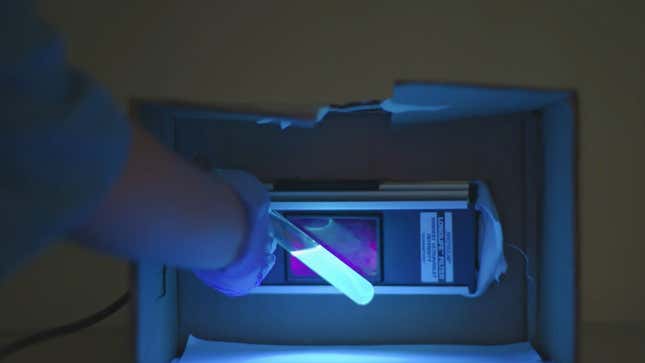
Apparently, rotting vegetables can be good for something other than fertilizer. Instead of literally going to waste, they can be upcycled to create a material that absorbs stray ultraviolet rays and turn it into renewable energy.
The material is called AuREUS and is the brainchild of Carvey Ehren Maigue, a 27-year-old engineering student from Mapúa University in the Philippines. For the invention, Maigue is also this year’s recipient of the James Dyson Award in the sustainability category. Basically, crop waste—including certain rotting fruits and veggies—contains luminescent particles. Maigue figured out a way to suspend those particles in a resin substrate. When ultraviolet rays come in contact with the material, those particles then absorb and re-emit visible light along the edges—the same principles that generate the aurora borealis. The main difference is that Maigue placed photovoltaic cells along the edges of the material, which then turns the captured energy into DC electricity.
The cool thing about AuREUS is that unlike solar panels, the material doesn’t need to directly face the sun as it can also be powered by scattered ultraviolet rays. That means it can work on cloudy days or in crowded cities. One use could be affixing AuREUS to skyscrapers windows to create vertical solar energy farms that can provide clean, renewable energy to cities. Maigue also noted that commercial glass uses a special film that reflects ultraviolet light away from buildings and toward passersby. Theoretically, AuREUS would be able to absorb that extra ultraviolet light, on top of converting organic trash into something useful.
“We need to utilize our resources more and create systems that don’t deplete our current resources,” Maigue said in an interview. “With AuREUS, we upcycle the crops of the farmers that were hit by natural disasters, such as typhoons, which also happen to be an effect of climate change. By doing this, we can be both future-looking and solve problems that we are currently experiencing now.”
This is actually Maigue’s second attempt at the James Dyson Award. The first time was in 2018, but Maigue didn’t make it to the final rounds. At that time, Maigue was trying to create a window that harnessed sunlight to create electricity. Ultimately, he wasn’t able to do that with glass and instead refined the idea to work with other materials and technology.
So, when will the rotting veggie windows come to a city near you? Unfortunately, not soon. Maigue said his future plans include further research and development so that 100% of the luminescent particles are sourced from fruits and vegetables (it’s currently 80%). Additional funding is also needed to figure out manufacturing logistics. Still, it is a pretty neat way to use rotting produce that would otherwise go to waste and produce climate-warming gases as it decomposes.